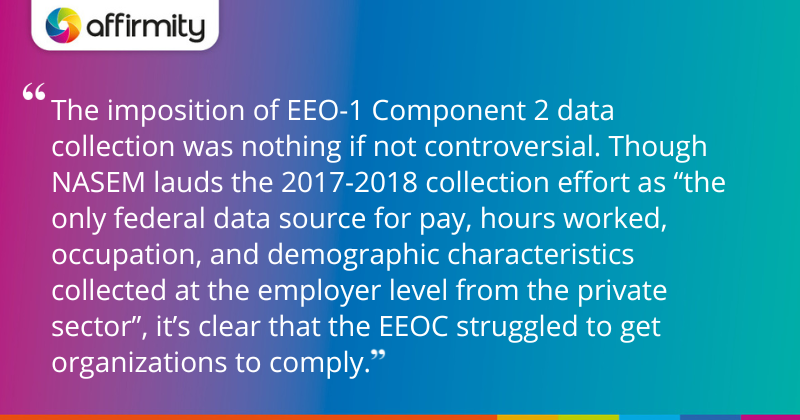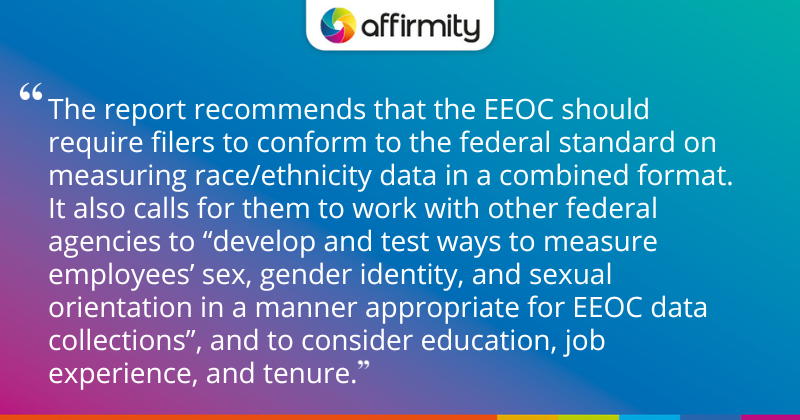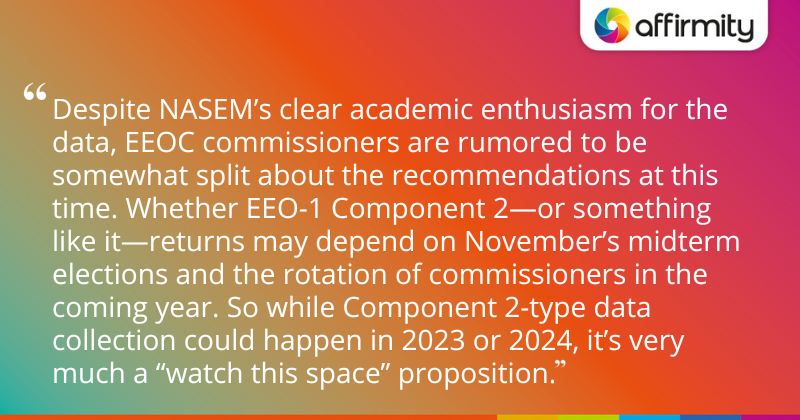The National Academies of Sciences, Engineering, and Medicine (NASEM) recently released a report on “the design, operations, and unique circumstances” of compensation data collected via the EEO-1 Component 2 form. In this article, we examine how the findings of this EEOC-sponsored study could lead to changes in how your affirmative action data is collected.
Background: The Return of EEO-1 Component 2?
Employers will remember that back in their 2017 and 2018 reporting years, the EEOC (in a joint effort with the OFCCP) expanded its EEO-1 data collection efforts. This new “Component 2” data requirement included the measurement of pay and hours worked in addition to the usual data on sex, race/ethnicity, employee headcount, and employer characteristics (“Component 1” data).
The Component 2 requirement had seemed to be a short-lived one. In September 2019, the EEOC announced it was not renewing its request for authorization to collect Component 2 data, citing issues with its original burden analysis. However, we’ve recently seen the OFCCP say it may have been “premature” in issuing a notice saying it “didn’t expect to find significant utility in the data.”
Does NASEM’s study indicate that Component 2 is also back on the menu at the EEOC? The EEOC commissioned the study in 2020, tasking NASEM with “examining the quality of the newly collected data and providing recommendations for future data collection efforts.” Though NASEM found “significant concerns in employer coverage, data collection protocols, measurement implementation, and conceptual definitions”, its conclusion is that the data collected in 2017-18 has value.
NASEM’s report, along with a recent panel webinar, have been a key topic of discussion at Affirmity. Coupled with insights gained from follow-up conversations with NASEMs panelists and others “in the know”, we’ve compiled the following list of key takeaways for employers concerned about future data collection requirements.
ALSO ON THE BLOG | ‘Your 6-Step AAP Maintenance Plan for Staying Ahead of Contractor Portal Certification’

Takeaway #1: Nothing Should Happen Without Employers Being Part of the Process
The imposition of EEO-1 Component 2 data collection was nothing if not controversial. Though NASEM lauds the 2017-2018 collection effort as “the only federal data source for pay, hours worked, occupation, and demographic characteristics collected at the employer level from the private sector”, it’s clear that the EEOC struggled to get organizations to comply. NASEM found that:
- The EEOC only actively reached out to 65% of eligible firms and establishments
- Only 58% of eligible firms completed the survey
- While 82% of eligible establishments provided a response, only 55% provided pay data
- When unreliable data is excluded, the EEOC only had data for 47% of eligible firms and 36% of eligible establishments
Considering these shortfalls, it’s unsurprising that NASEM repeatedly stresses through both its report and webinar that its recommendations should be vetted with the employer community and adequately field-tested before rollout.
YOU MAY ALSO FIND THIS USEFUL | ‘4 Important Actions That Will Strengthen Your Affirmative Action Plan Narratives’
Takeaway #2: The EEOC Is Being Told to Narrow Its Categorization
The report concludes that the demographic categories in use in 2017/18 were too broad, and that narrowing them down could significantly increase the usefulness of the data.
The report recommends that the EEOC should require filers to conform to the federal standard on measuring race/ethnicity data in a combined format. It also calls for them to work with other federal agencies to “develop and test ways to measure employees’ sex, gender identity, and sexual orientation in a manner appropriate for EEOC data collections”, and to consider education, job experience, and tenure.
This suggestion is perhaps not entirely surprising. After all, the EEO-1 reporting format was established in 1966, and the way that companies and societies categorize groups has undeniably changed in the last six decades. NASEM suggests that, provided data is collected appropriately, the extra information could improve the EEOC’s initial investigation of pay disparities while also benefiting employers’ self-assessment activity.

Takeaway #3: Collection of Individual Worker Data Seems Inevitable in the Long Term
One of NASEM’s bigger criticisms is that the use of aggregate pay and hours during 2017/2018 Component 2 data collection both “severely limited the utility of the data collected” while also significantly increasing employer workload.
It argues that collecting data at the level of individual workers is already the norm in a number of other contexts—mentioning The Bureau of Labor Statistics’ Occupational Employee Wage Survey, and data collection for tax, social security, and unemployment insurance purposes. We’ve also seen a similar requirement finding its way into state-level pay equity measures, such as the Illinois Equal Pay Act.
In its subsequent webinar, NASEM clarified that it recommended collecting W-2 Box 5 (total compensation) at the individual employee level and re-emphasized that data collection at this level is practiced securely in several agencies. As many organizations already express data in this way, it would help streamline the process if the EEOC reinstates EEO-1 Component 2.
RELATED READING | ‘What Do 2022’s New OFCCP Directives Mean for Your Organization?’

Takeaway #4: The Return of EEO-1 Component 2 Isn’t a Done Deal
The report ultimately concludes that by collecting pay data, the EEOC is better able to determine where to start investigating issues, and that adjustments to what it collects could also lead to improvements in employers’ self-analyses.
However, despite NASEM’s clear academic enthusiasm for the data, EEOC commissioners are rumored to be somewhat split about the recommendations at this time. Reactions are said to be a mix of positive and negative, with a high degree of caution expressed.
If this is indeed the position of the EEOC, whether EEO-1 Component 2—or something like it—returns may depend on November’s midterm elections and the rotation of commissioners in the coming year. So while Component 2-type data collection could happen in 2023 or 2024, it’s very much a “watch this space” proposition.
With Affirmity’s support, you’ll always be kept informed about upcoming changes to your reporting obligations. Contact us today and find out how we can help.
 About the Author
About the Author
Patrick McNiel, PhD, is a principal business consultant for Affirmity. Dr. McNiel advises clients on issues related to workforce measurement and statistical analysis, diversity and inclusion, OFCCP and EEOC compliance, and pay equity. Dr. McNiel has over ten years of experience as a generalist in the field of Industrial and Organizational Psychology and has focused on employee selection and assessment for most of his career. He received his PhD in I-O Psychology from the Georgia Institute of Technology.
